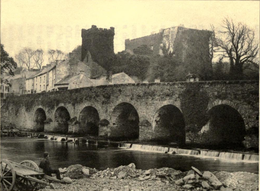Macroom Castle
The castle ruin stands further west on the steep right bank of the river just upstream (south) of the bridge.
[2] It consists of an arched passage surmounted by a guard chamber and flanked by two round turrets (towers).
Most of this ensemble is built from grey rubble stone, except the front of the guard chamber which looks like ashlar but is only a facing formed by plates of slate.
This building had been fashioned before 1750 by filling the gap between two older square or rectangular towers of similar height and reorganising the resulting house inside and outside.
The castle's west-wing once linked the surviving tower to the now missing main residential block.
The central bay forms a projecting break-front that has a gate with a pointed arch and a crow-stepped gable.
[6] The castle's old Irish name Caisleán Uí Fhloinn suggests that it once belonged to the O'Flynns,[7] who owned much land in this part of Muskerry before they were superseded by the MacCarthys.
[9] During Tyrone's Rebellion after the Spanish had landed in Kinsale and had been driven out of it again, it became known that Cormac MacDermot MacCarthy, 16th Lord of Muskerry had been in secret communication with them.
[17] In 1645, during the Irish Confederate Wars, the Papal Nuncio Giovanni Battista Rinuccini visited Macroom Castle where Lady Muskerry and her 11-year-old eldest son, Charles, received him while her husband Donough MacCarty, the 2nd Viscount Muskerry, was negotiating with Ormond, the Lord Lieutenant, in Dublin.
The sheriff was shot, but the bishop was offered his freedom if he could persuade the garrison of Carrigadrohid Castle to surrender.
During the Williamite war in Ireland Donough MacCarty, 4th Earl of Clancarty, turned Jacobite and let on 11 September 1689 Macroom Castle be used as a prison for Protestants evicted from Cork.
It was acquired by the speculatory Hollow Sword Blade Company, who resold it to Francis Bernard, later the 1st Earl of Bandon.
[27][28] The Gatehouse and the Market House[29] were both built in the early 19th century (before 1824) as part of a plan to embellish the town centre and the marketb place.
In 1924 Olivia, a descendant of the MacCarthy chiefs, and widow of Lord Ardilaun, sold the castle demesne to a group of local businessmen, to be held in trust for the people of the town.

